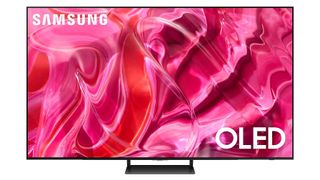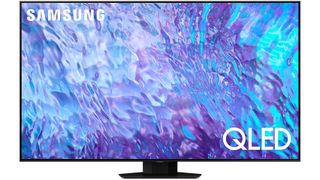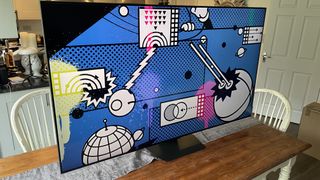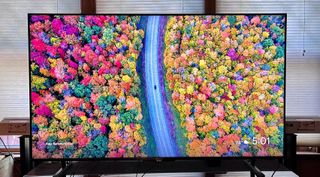OLED vs QLED: Which TV tech is the best?
Here's everything you need to know about OLED and QLED TVs

Best for: picture quality
Organic Light-Emitting Diode displays take the crown right now as the best premium TV tech around. You get better viewing angles, deeper blacks – and therefore better contrast for HDR – and they consume less power. They’re often a better option for gaming, but can cost more.
Choose one:
The best OLED TVs
For
- Lighter and thinner
- Precise colors
- Deeper black tones
Against
- Small risk of burn-in
- Limited full-screen brightness
- More expensive

Best for: value for money
Quantum dot LED TV displays have a potentially brighter picture than OLED, are mostly cheaper and still come with a lot of similar features. They'll offer great bang for your buck, but their contrast, black levels and even colors won't be as accurate as OLED.
Choose one:
The best Samsung TVs
For
- Vivid colors
- High brightness potential
- More budget friendly
Against
- Potential backlight blooming
- Inconsistent black tones
- Contrast not as strong as OLED
What's the difference between OLED vs QLED? You've likely encountered these tech terms while scouring the web for a new TV, but understanding the key differences between them isn't always easy.
While OLED generally does deliver the more 'premium' experience thanks to its more accurate picture, this isn't always what's best. QLED TVs offer better overall brightness and value, without sacrificing too many features nowadays. It all comes down to which one suits your viewing environment better.
Even when it comes to performance, what makes a premium picture and a top-quality watching experience isn't the same for everyone. Some people might prefer the deep and detailed shadows of the best OLED TVs. Others would opt for the rich quantum dot color and high brightness of the best QLED TVs. (And if you don't know what any of those terms mean, read on.)
For an in-depth exploration of each, look at our what is OLED and what is QLED guides. Or, read on, where we'll simplify the jargon and ensure you have all the information you need to pick between the two technologies.
Whether you're hoping to find one of the best 85-inch TVs to create a cinema-like experience, one of the best gaming TVs for your PS5 or Xbox Series X or you're looking for one of the best 40-inch TVs for the bedroom, read on to find out which tech is likely to suit you better.
OLED vs QLED: the current state of TV tech
The biggest and best TV makers, like LG, Panasonic, Philips and Sony have supplied OLED TVs for years. OLED is still arguably considered the most premium consumer TV tech available and debatably the most popular. Even Samsung, who opposed OLED at one stage, joined the OLED market with its QD-OLED TVs.
The most popular OLED TVs remain LG, though. Some of the most popular models include the LG C3, LG G3, LG B3, Sony A80L and many more. These OLEDs in particular feature amongst the best TVs available.
QLED TVs, on the other hand, are mostly made by Samsung, although you will find them from other brands too, like Sony, Hisense, TCL and Amazon. One of the best rated examples of these recently is the Samsung Q80C.
It's also worth mentioning mini-LED TVs. Although technically a separate form of tech, these TVs feature microscopic lenses within the backlight (more below) do use some form of QLED tech in their panels.
It's also worth mentioning QD-OLED TVs. This combines the best of both worlds, using a blue OLED panel with a quantum dot filter to create brighter primary colors. As a result, you get the stronger contrast of OLED and higher brightness of QLED within one TV.
QD-OLED was introduced to the market by Samsung in 2022 and has been more refined and grown in popularity ever since. So much so, that the Samsung S90C, a 2023 QD-OLED, was TechRadar's TV of the Year at the TechRadar Choice Awards 2023.

OLED vs QLED: the case for organic LED
Pros:
Self-emissive pixels
More convincing black tones
Accurate textures and colors
Cons:
Limited full screen brightness (generally up to 300 nits)
Expensive compared to QLED
To back track just a little bit, OLED stands for Organic Light Emitting Diode. This type of TV uses a carbon-based film between two conductors that emits its own light when an electric current is passed through.
Since the pixels themselves are producing the light, when they need to be black they get switched off completely. That means no chunky LCD backlight, remarkably realistic blacks, gorgeous contrast and accurate details and colors.
However, OLED TVs are getting brighter. In recent years, LG introduced micro-lens-array (MLA) tech into TVs such as the LG G3 OLED and peak brightness levels surpassed 1,000 nits, hitting 1,449 nits when we measured it in our tests. But this is peak brightness we're talking about.
As we said above, OLED's main problem is full screen brightness. Peak brightness levels are often measured on 3-10% windows, while OLED TVs on 100% windows often yield results of between 200-300 nits, which is over half of what QLED TVs such as the Samsung Q80C can offer.
Although OLED is also generally becoming more affordable, it's still significantly pricier than QLED, and even mini-LED TVs. When you look to buy a premium tech like OLED, you expect to pay a premium price.

QLED vs OLED: the case for quantum dots
Pros:
Vibrant colors
Brighter than OLED (full screen)
Variety of screen sizes between 32- and 98-inch
Cons:
Backlight blooming can occur
Black uniformity issues due to LED backlight
Contrast not as strong as OLED
QLED's strength lies in its higher brightness levels and until recently, much wider variety of sizes. It also still boasts rich contrast in its more premium models such as the Samsung Q80C. But what does QLED, which stands for quantum dot LED, do?
What makes it 'quantum', according to Samsung, is that it uses a quantum dot colour filter in front of its LCD backlight, which improves brightness, contrast, and color vibrancy. Technically, QLEDs should be called QLCD-LEDs, so we can't complain too much about its existing name. So, really, it's not a next-gen display technology at all, but just a tweak to LCD TV tech. However, that doesn't mean it's not impressive – it really is very good.
There's also the mini-LED TVs, which use a form of QLED tech, like we mentioned above. Mini-LEDs are microscopic in size, which means more can be placed in an LCD panel. This allows for dimming zones resulting in better lighting control and greater control of contrast compared with standard LED TVs. However, mini-LED is still technically a separate form of panel altogether.
Where QLED often falters is in its black levels and contrast. Limited by the LED backlight, QLED TVs can suffer from black uniformity issues (the ability to spread black tones evenly across the screen) and backlight blooming (a halo effect around objects). QLED's contrast levels, while still very good, also can't beat those of OLED TVs.

OLED vs QLED: what's the best choice for gamers?
When it comes to choosing the best gaming TV for you, looking at OLED vs QLED can be important depending on where your gaming setup is, but the key things to look out for are certain gaming features designed to get the best out of your consoles.
The features to look out for are HDMI 2.1 ports that will feature 120Hz refresh rate (which the PS5 and Xbox Series X support), VRR (which includes AMD FreeSync and Nvidia G-Sync) and ALLM. Depending on how many next-gen consoles you have, you'll also want to make sure how many HDMI 2.1 ports a TV has.
Generally, the gap between OLED and QLED TVs when it comes to gaming features has narrowed in recent years. OLEDs initially had superior gaming performance all around with a stack of features (other than the budget LG A2) and when coupled with OLED picture, made the perfect gaming TV.
However, some QLEDs, such as the Samsung Q80C, and mini-LED TVs, like the Hisense U8K and Samsung QN90C, are bringing all these gaming features as well and backing it up with strong performance. The main difference is QLEDs carry that brighter picture.
When it comes down to it, it really does depend on where you do your gaming. Brighter rooms will benefit from QLED or mini-LED, darker rooms or those with suitable means to quell reflections will probably want to look to OLED.

OLED vs QLED: which is right for you?
Both of these technologies are impressive – but for different reasons. OLED has superior contrast to QLED thanks to its individually dimming pixels while QLED has the superior full-screen brightness. Both have spectacular colors in their own way that will suit different people.
If your viewing environment doesn't suffer from bright conditions, then OLED will probably suit you better. The OLED panel will give you better black levels and that fantastic contrast we've mentioned before, but in a brighter room it will suffer from reflections (although Samsung's 2024 QD-OLED the Samsung S95D is introducing an OLED Glare Free screen to limit reflections).
Despite increased brightness in OLED TVs in recent years, QLED still remains better for overall brightness. If you have a well-lit room, you're better off suited to QLED, as its much brighter panel will handle reflections better. If you prefer your colors brighter as well, QLED will suit you more.
In terms of features, OLED and QLED TVs are both starting to carry very similar sets of connections for gaming, HDR formats (although you won't find Dolby Vision on Samsung sets) and other similar compatibilities so it really does come down to what your viewing environment is like.

OLED vs QLED: what does the future look like?
The future for both OLED and QLED sounds exciting, with a couple of intriguing enhancements being developed for both technologies. It seems like energy efficiency and brightness are the real focus areas for brands.
For OLED, ink-jet printed (IJP) OLEDs could be on the way, resulting in a brighter picture and hopefully cheaper prices, as IJP production methods would be significantly cheaper than current OLED production methods.
There is also Phosphorescent OLED (PHOLED), another different method of production that again promises higher brightness and more energy efficiency not only during production but at home as well, producing less heat than current OLED technology.
Even traditional OLED TVs are starting to develop, with 4,000 nits panels potentially on the way, although a lot of brands including LG and Samsung are aiming for 3,000 nits to start with.
As for QLED, the future focus seems to be on direct view quantum dot tech, which would mean the quantum dots themselves would be the light source, rather than relying on an LED backlit panel. This may also mean the 'self-emissive' quantum dots can produce better black levels and contrast akin to OLED TVs.
OLED vs QLED: verdict
Of OLED and QLED, we believe that the overall better technology is OLED. Thanks to its self-emissive pixels, you get the most accurate picture on screen, with superb black levels and contrast and the best textures and sharpness overall.
That's not to say QLED is a bad technology, as its increased brightness and vivid colors still give it a fantastic picture. It's also cheaper than OLED and comes in a larger variety of sizes (32- to 98-inch as opposed to OLED's 42- to 97-inches), but if we're looking purely at picture quality, OLED is indeed the best of the two.
Again though, it does all boil down to what TV is going to suit your room best. Don't be discouraged if you end up having to choose QLED over OLED or vice versa – there are plenty of fantastic options out there for both.
Get daily insight, inspiration and deals in your inbox
Get the hottest deals available in your inbox plus news, reviews, opinion, analysis and more from the TechRadar team.
Henry is a freelance technology journalist, and former News & Features Editor for TechRadar, where he specialized in home entertainment gadgets such as TVs, projectors, soundbars, and smart speakers. Other bylines include Edge, T3, iMore, GamesRadar, NBC News, Healthline, and The Times.
- Nick Pino
- Jamie Carter
- James DavidsonTV Hardware Staff Writer, Home Entertainment

